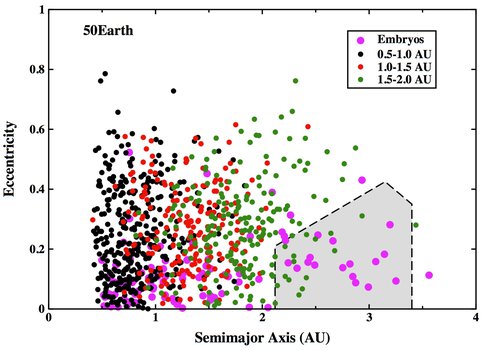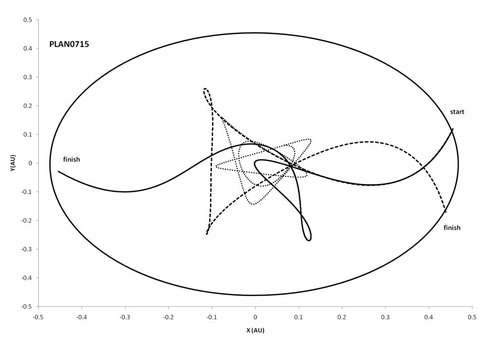2011 Annual Science Report
 University of Hawaii, Manoa
Reporting | SEP 2010 – AUG 2011
University of Hawaii, Manoa
Reporting | SEP 2010 – AUG 2011
Solar System Dynamics
Project Summary
Understanding how the planets accumulated requires a detailed investigation of the dynamical pro-cesses that were occurring at the time of accretion. UHNAI team members are using dynamical sim-ulations involving many particles to help interpret some of the observable aspects of the modern solar system.
Project Progress
“Reconciling Giant Planet Formation with the Origin and Impact Hisotry of the parent Bodies of Differentiated meteorites”
The extraordinary number of different parent bodies of iron meteorite, and the dearth of asteroids and meteorites derived from the silicate mantles and crusts of these objects is better understood if these bodies accreted at 1-2 AU during the first 2 Myr when 26Al melted all icefree planetesimals larger than 20 km. It has been suggested that planetary embryos at 1-2 AU dynamically excited the differentiated planetesimals and scattered their fragments into the asteroid belt where they were captured by planetary embryos. The scattering and accretion of planetesimals has occurred during the time that giant planets were growing. If the timescale for the formation of giant planets is comparable with the time of the accretion of parent bodies of iron meteorites (e.g. as short as in the recent version of the coreaccretion model), or if it is as small as suggested by the disk instability scenario, the perturbation of growing giant planet(s) may affect the scattering, collision, and accretion of planetesimals. We have studied these effects in order to compare the results with meteoritic data to constrain the time of giant planet formation. The first stage of our project is complete and a paper has been submitted for publication where we have numerically integrated the motions, collisions, and accretion of a large battery of planetesimals and planetary embryos in the region between 0.5 and 4 AU during the growth of Jupiter. Results indicate that the perturbations of growing giant planets decrease the efficiency of planetesimals scattering when these objects grow to approximately 50 Earthmasses (Figure 1). We are continuing our study to examine the effect of a second giant planet in the orbit of Saturn, and the effect of varying disk surface density, gas drag, and planet migration as in scenarios such as the Nice or Grand Tack models.
Planetesimal Simulations (a). Results of the numerical integration of the perturbation of planetesimals in the region between 0.4-4.0 AU as Jupiter was growing. Once the objects grow to 50 earth-masses, the efficiency of planetesimal scattering decreases.
Planetesimal Simulations (b). Results of the numerical integration of the perturbation of planetesimals in the region between 0.4-4.0 AU as Jupiter was growing. Once the objects grow to 50 earth-masses, the efficiency of planetesimal scattering decreases.
“Contribution of Planetesimals to the Composition of Gas-Giant Planets”
The interaction of planetesimals with the gaseous envelope of a giant planet during the envelope’s contraction has been studied in the disk instability model. We considered a system consisting of the Sun, protoJupiter, and a protoplanetary disk. The disk contained 15000 objects with sizes of 1,10, and 100 km at two regions, 3.7-4.0 AU and 6.2-6.6 AU. The combined mass of the core and atmosphere of the protogiant planet was set equal to the mass of Jupiter, and the radius of its envelope was taken to be 0.5 AU. The planetesimals were assumed to be composed of different materials: pure iron, pure rock, pure ice, or a mixture of rock and ice. When as a result of interaction with the gas, the ice is melted, any rock that is embedded in it, is assumed to have been deposited in the envelope.
We integrated the orbit of each planetesimal taking into account the gravitational forces of the planet and the Sun. We followed the evolution of each object and identified those that entered the giant planet’s envelope. The figure shows the results of some of our simulations. The objects shown here have identical bulk densities (1 g/cc). As seen from this figure, depending on the location where the planetesimal enters the envelope and also depending on its size, this object may pass through the envelope and deposit some of its material, or may be captured entirely. Simulations show that the rate of capture is higher for smaller planetesimals. Results also show that small planetesimals that consist of a mixture of ice and rock deposit larger amounts of mass as they interact with the envelope. Our project is continuing where we are now including a second giant planet in the orbit of Saturn and study the effect of giant planets’ secular resonances.
The results of the simulation of the interaction of planetesimals with the gaseous envelope of a giant planet during formation. Objects may pass through the envelope and deposit material, or may be captured.
Publications
-
Haghighipour, N., & Scott, E. R. D. (2012). ON THE EFFECT OF GIANT PLANETS ON THE SCATTERING OF PARENT BODIES OF IRON METEORITE FROM THE TERRESTRIAL PLANET REGION INTO THE ASTEROID BELT: A CONCEPT STUDY. The Astrophysical Journal, 749(2), 113. doi:10.1088/0004-637x/749/2/113
- Haghighipour, N. (2011). Collision and Out-Scattering of Planetesimals from Terrestrial Region in to the Inner Asteroid Belt: The Effect of Disk Surface Density. Bulletin of the AMerican Astronomical Society, 43. doi:2011DDA….42.0907H
- Haghighipour, N., Scott, E.R.D., Taylor, G.J. & O’Brien, D. (2010). Reconciling Giant Planet Formation With the Origin and Impact History of the Parent Bodies of Differentiated Meteorites. Annual Meeting of the Division of Planetary Science, American Astronomical Society. Pasadena, CA.
-
PROJECT INVESTIGATORS:
-
PROJECT MEMBERS:
Nader Haghighipour
Project Investigator
Ed Scott
Co-Investigator
Jeff Taylor
Co-Investigator
Ravit Helled
Collaborator
Morris Podolak
Collaborator
-
RELATED OBJECTIVES:
Objective 1.1
Formation and evolution of habitable planets.


